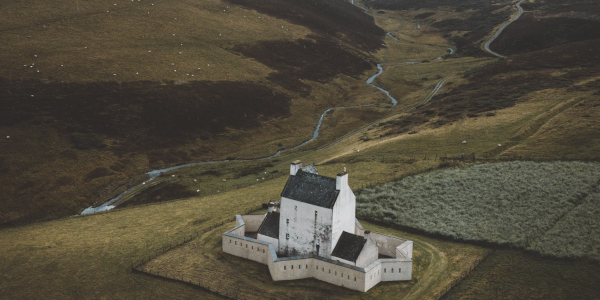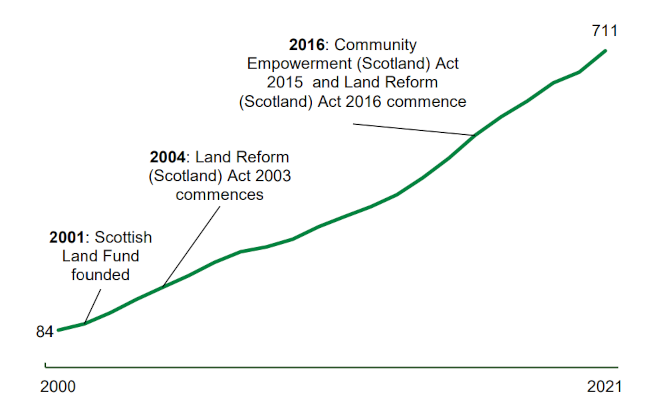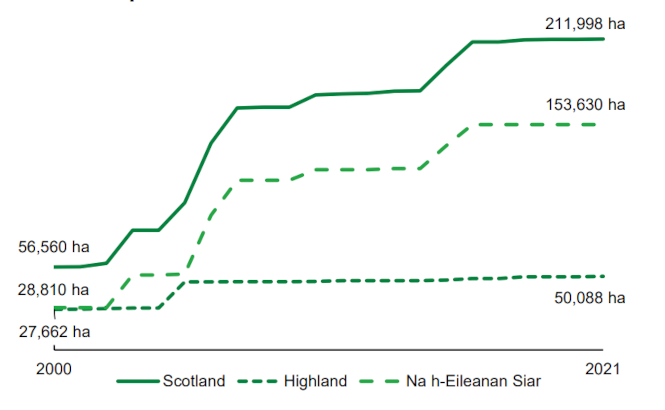“The free society is characterized by the radical decentralization of all kinds of power. Confederal structures do not rule over communities; they are the means by which communities cooperate.” – Roy San Filippo
(This blog post previously appeared on Bella Caledonia.)

The Scottish government has introduced land reform legislation to encourage community ownership by granting ministers powers to intervene in the sale of estates of more than 1,000 hectares. The ruling Scottish National party said the bill, the biggest package of reforms in years, aimed to “revolutionise land ownership in Scotland” by empowering rural and island communities and increasing transparency in large land transactions.
In 2016 the last round of Land Reform made it easier for communities to buy out parcels of land, however the rampant rise in land prices – often now driven by so-called “Green Lairds” looking to cash in on carbon credits – have locked those same communities out of being able to afford to buy that land. With a few exceptions – such as in Langholm – the parcels of land being bought by communities have been getting smaller. A report published in 2022 found that despite a steady rate of successful community buyout projects continuing much as it had since the start of devolution, the actual hectarage of land transferred had all but stalled with around 97% of all community owned land in Scotland being transferred before the passing of the 2016 Act.

(The number of community owned assets in Scotland since 2000)

(The land area owned by communities in hectares)
In short, since then it has become easier to buy out your village hall, but harder to buy out your village. The high profile failure of the community in Tayvallich to buy out the land around them is an example of this as they were locked out by land price rises driven increasingly by the speculative carbon credit market – the land having doubled in value over the few years prior to the sale of the estate.
Last week, the Scottish Government published its Land Reform for a Net Zero Nation Bill, the latest attempt to catch Scotland up to the kind of land reform our European peers enacted in the 19th and 20th centuries. It promises much more progress than previous attempts with stronger rights granted to communities who wish to take control of the land under their feet as well as to break up larger estates and to force those large estates which remain to be managed better.
As a result of public consultation, there have been some changes to the draft Bill that was introduced in 2022 however they have been fairly minimal. The most headline grabbing change is around the definition of a “large landholding” – the kind of estate that would be subject to the most scrutiny and highest burden of regulation such as being forced to produce a Land Management Plan and demonstrating adherence to it. In the draft Bill, the minimum size of a “large landholding” was set at 3,000 hectares – about the size of Inverness – with Government officials stating at at least one public meeting that the motivation for this number was specifically to minimise the number of estates captured as this minimised the cost to the government of overseeing the regulations (not that the fines for breaching such regulations are anywhere near sufficient at a maximum of £5,000 per breach). Land reform campaigners, including Common Weal, called for that limit to be lowered to at least 500 hectares. The Government partially relented, reducing their limit to 1,000 hectares, though the language of the Bill is not entirely clear on how it relates to multiple landholdings. It will not be possible to split one estate into multiple legal parts to duck under the limit but I’m not sure that also applies if one person owns two or more 999ha estates and even less sure it applies if they own, for example, a 50% share in a hypothetical company that owns 2,000ha of land either as a single estate or scattered across Scotland.
Our biggest concern in the Bill as it stands though is the level of control it grants to Ministers. We have always said that land reform and local democratic reform go hand in hand. The Bill contains welcome provision on how a large estate that comes up for sale (or transfer via inheritance etc) can be paused for up to two years to give the community a chance to decide if it wants to enact a right to buy and to raise the funds to do so though, unlike Mercedes Villalba’s Land Ownership and Public Interest (Scotland) Bill there is little power for a community to proactively prompt the transfer of land. There is an equally welcome provision that allows for large estates to be broken into lots at the point of sale, again which may allow communities to buy a parcel or two of the estate – though Ministers will be in control of drawing the lines on the map and deciding which bit of land goes into each lot. However, both of these clauses are entirely at the behest of the Ministers and provisions exist that allow either or both to be overridden if, for example, the landowner pleads financial hardship as a result of delays in the sale. An extremely worrying clause also exists that provides for public compensation for landowners if they lose out financially as a result of the estate being lotted. In other words, if your £10 million estate is broken into lots and you’re only able to sell them for a total of £8 million, the Scottish Government may well pay you the difference.
Contrast that with the fact that there is no similar provision to fund communities who wish to enact their right to buy and this remains the largest barrier to actual land reform facing Scotland. If you have a right to buy the land you live on but there’s no possible way for you to raise the money to enact that right then that’s not a breach of your rights, that’s just you being an insufficiently good capitalist, isn’t it?
This Bill has the potential to be another powerful, though incomplete, step towards land reform in Scotland but unless it is coupled to local democracy so that communities – not Ministers – are in charge of the process and to a mechanism of reducing the price of land – such as via a land tax – so that communities can enact their rights then all this Bill looks like it will do is pull power ever more tightly into the grasp of Scottish Ministers and give the Lairds (“Green” or otherwise) even more power to lobby those Ministers to maintain the status quo. This is not good enough and with a successful campaign under our belts to prevent this exact same kind of power grab within the National Care Service Bill, we do hope we can convince the Government to let go of this one too.
We’ll continue to campaign for the kind of land reform that will bring Scotland in line with the norms of our European neighbours where communities not only own the land under their feet but have full and local democratic control over it too.
